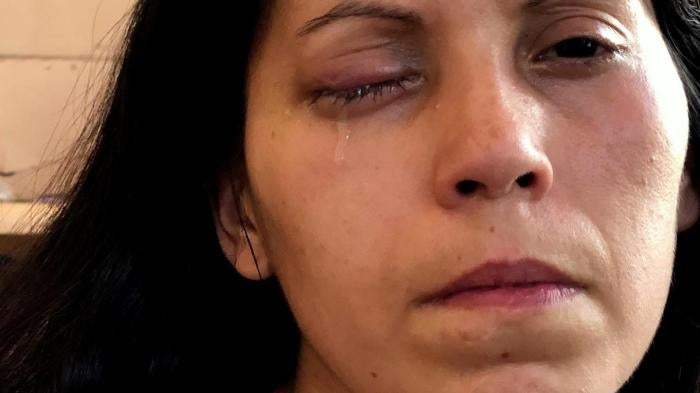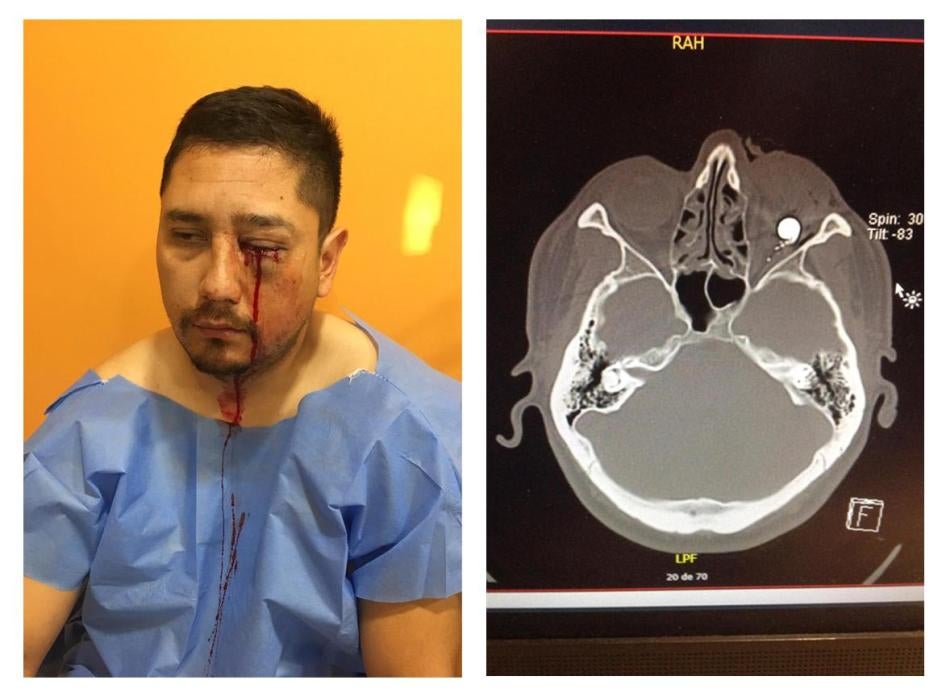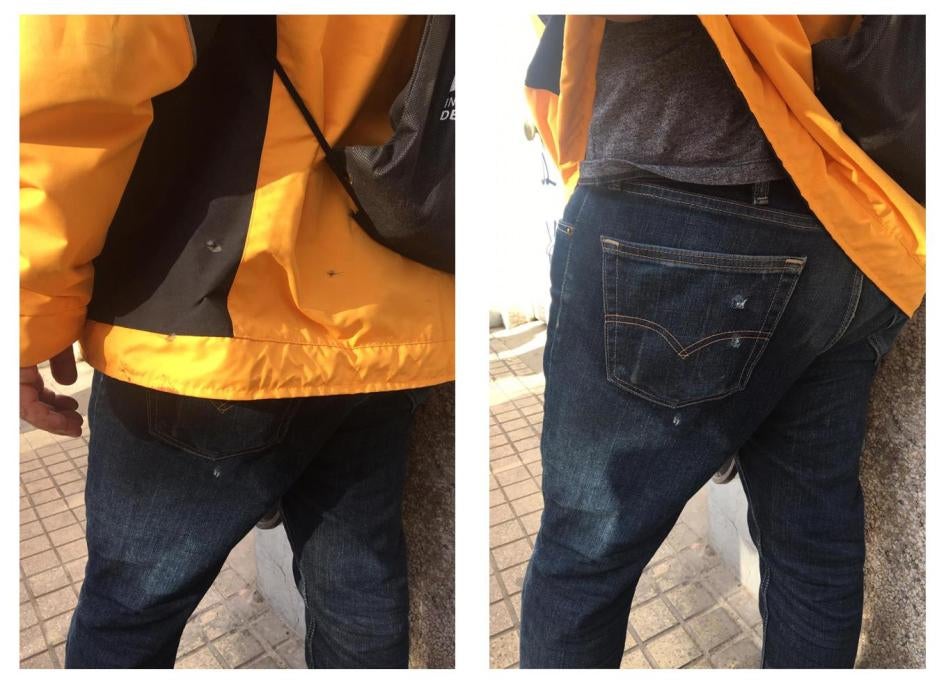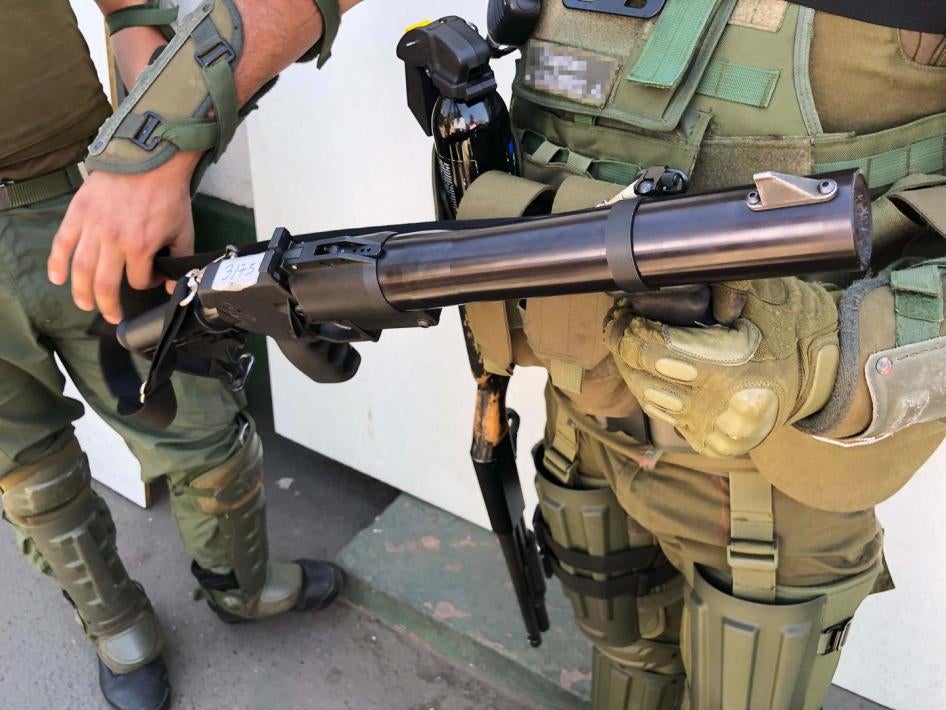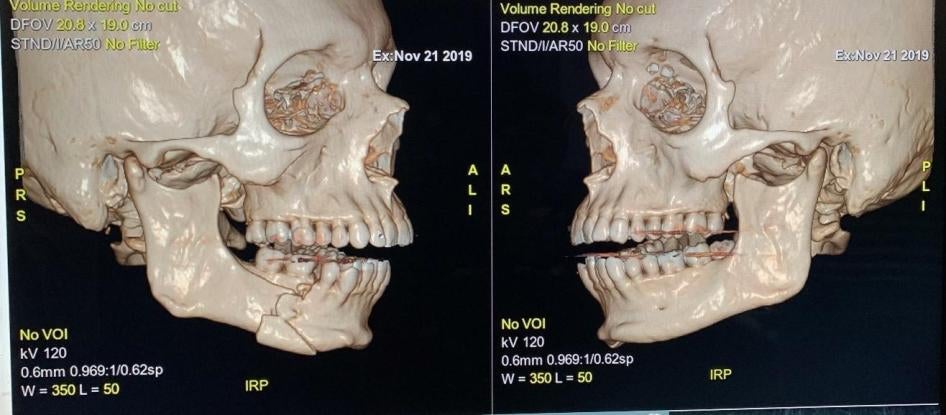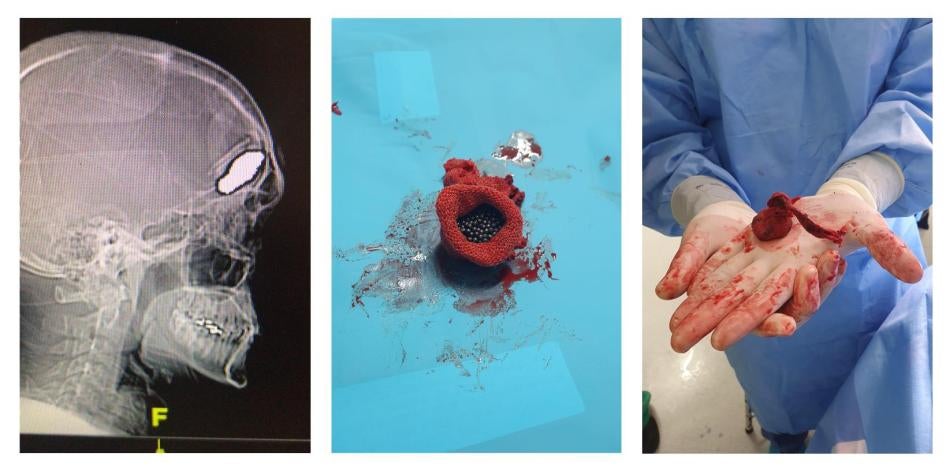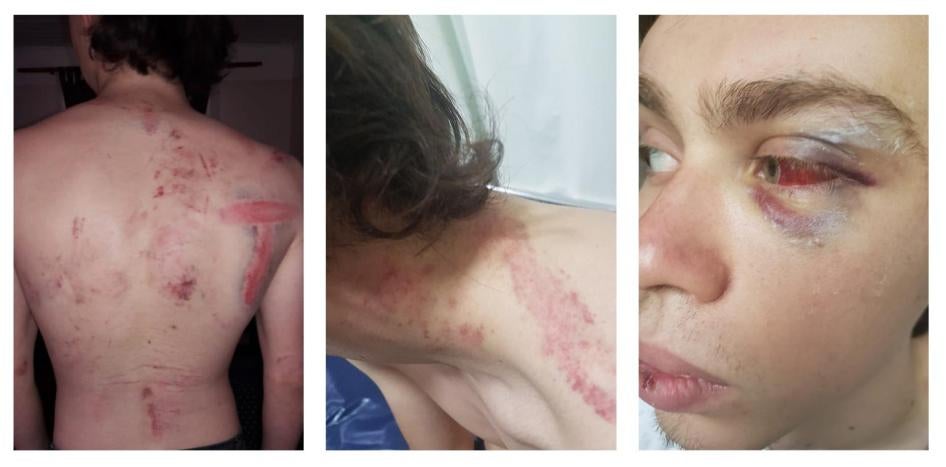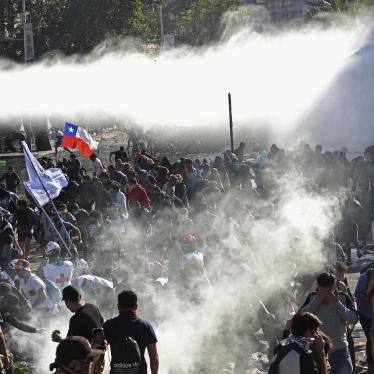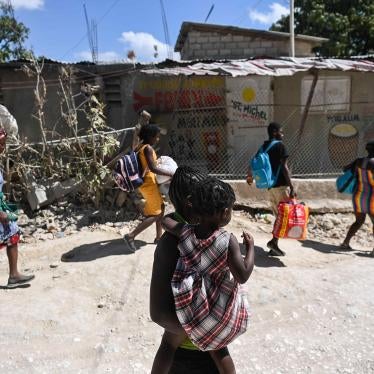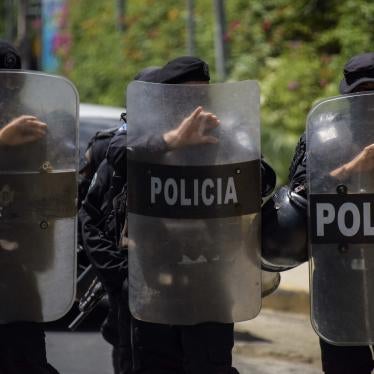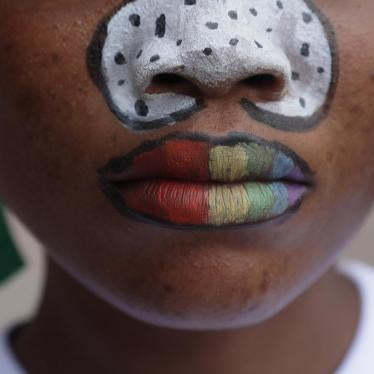(Santiago) – Chile’s national police, Carabineros, committed serious human rights violations, including excessive use of force in the streets and abuses in detention, after thousands of Chileans took to the streets on and in the weeks following October 18, 2019, Human Rights Watch said today.
Human Rights Watch met with President Sebastián Piñera on November 26 and recommended a series of reforms directed to help prevent police misconduct and strengthen oversight in the wake of compelling evidence of excessive use of force and abuses against demonstrators and bystanders. From the beginning of the demonstrations through November 21, the National Human Rights Institute filed 442 criminal complaints on behalf of victims with prosecutors, regarding injuries, cruel treatment, torture, rape, killings, and attempted killings allegedly committed by security forces.
“There are hundreds of worrying reports of excessive force on the streets and abuse of detainees, including brutal beatings and sexual abuse, that should be promptly and thoroughly investigated to ensure victims’ access to justice,” said José Miguel Vivanco, Americas director at Human Rights Watch. “Issues such as the indiscriminate and improper use of riot guns and shotguns, abuse of detainees in custody, and poor internal accountability systems gave rise to serious violations of the rights of many Chileans. This is precisely why police reforms are urgently needed.”
The protests began over an increase in the price of public transportation and have continued for over a month. The demonstrations broadened to reflect anger over serious deficiencies in the provision of social services and economic inequality.
On October 18, Piñera declared a state of emergency in several locations, deploying the military to enforce it. The state of emergency, which included measures restricting freedom of movement such as curfews, was lifted on October 28. The national police responded to massive protests across Chile. While most demonstrators were peaceful, some groups engaged in violent acts, including attacking police officers and police stations with rocks and Molotov cocktails, looting, and burning public and private property. On November 21, the police command said that more than 1,896 officers were injured from October 18 to November 20, about 127 of them seriously.
Human Rights Watch interviewed more than 70 people in Santiago and Valparaíso in November. Some were victims who had been injured by pellets fired from shotguns or direct hits from teargas cartridges fired from riot guns; others alleged to have suffered police abuse in the streets or police stations. Human Rights Watch also interviewed police officers, some of whom had been injured by demonstrators, doctors, lawyers, academics, representatives of civil society, and government officials, including the Supreme Court president, the attorney general, the chief public defender, the police general director, and the foreign affairs, interior, defense, and justice ministers.
Human Rights Watch found compelling evidence that police used excessive force to respond to protests, injuring thousands of people, whether they were engaged in violent actions or not. The country’s emergency services treated 11,564 people injured during the demonstrations from October 18 to November 22, the Health Ministry told Human Rights Watch. Of those, more than 1,100 had moderate or serious injuries.
The use of shotguns that scatter pellets indiscriminately over a wide area with the potential to harm anyone in their path is of particular concern, Human Rights Watch said. The pellet shotguns were the main cause of the more than 220 eye injuries documented by the National Human Rights Institute, an official and independent body. On November 17, the Health Ministry reported that 16 lost eyesight in one eye and 34 had severe eye injuries that could result in partial or total eyesight loss, with their recovery depending on an assessment in the next three months.
On November 19, the police temporarily suspended the use of the pellet shotguns for crowd control at protests while external experts evaluate the composition of pellets. Given their inherently inaccurate nature, indiscriminate impact, and evidence of the serious injuries they have caused, their use should be suspended indefinitely in all circumstances until competent and independent authorities conduct a proper examination of their risks, Human Rights Watch said.
Police also brutally beat protesters, shot bean bag rounds and teargas cartridges directly at them, and ran over some with official vehicles or motorcycles.
The Attorney General’s Office is investigating 26 deaths. Among them are a demonstrator who died after an alleged police beating on the street, three protesters allegedly fatally shot by military forces using live ammunition, and one who was run over by a Navy vehicle, according to information from the Attorney General’s Office.
Medical personnel said that one demonstrator with a heart problem died when he did not receive proper emergency care, because police were using weapons against protesters and medical personnel. The Attorney General’s Office is also investigating the deaths of two men in police custody, which it is currently treating as suicides.
Human Rights Watch learned that at least another 18 people died in fires during looting, were run over by private cars during demonstrations, or died for other reasons without evidence, so far, that government agents played a role.
The police detained more than 15,000 people and ill-treated some of them.
Of 442 criminal complaints filed by the National Human Rights Institute on behalf of victims of abuse, 341 refer to allegations of torture and inhumane treatment and 74 of sexual abuse. Many detainees allege they were brutally beaten by police. Another of the most common allegations was that police forced detainees, including children, to undress and squat fully naked in police stations, a practice banned by police protocols in March 2019 but that still occurs, including before the protests.
The police appear to be more likely to force women and girls to strip than men, based on data that the National Human Rights Institute collected and interviews Human Rights Watch conducted. A Chilean human rights lawyer told Human Rights Watch of a case in which men and women were detained in the same circumstances, but only women were forced to undress, and cases of police touching women’s genitalia after they were forced to strip.
The Attorney General’s Office has opened preliminary investigations into alleged abuses against 2,278 people, in which 203 members of security forces are allegedly implicated, including 173 police officers. Only 9 – 4 police and 5 members of the Armed Forces – have been “formalized,” meaning that their cases moved to the next investigation phase.
Before the protests, the government adopted a protocol on the use of force and promoted it. During the protests, according to information provided by the government to Human Rights Watch, it took other measures, such as requesting security forces to implement the protocol and the deployment of 250 human rights police instructors to units engaged in crowd control operations.
The abuses in detention and the serious injuries suffered by hundreds of protesters were facilitated by structural failures of oversight and accountability that predate the current wave of demonstrations, Human Rights Watch said.
For detailed recommended reforms and further information on the Human Rights Watch findings, please see below.
Recommended Reforms
- Review police powers of detention during identity controls to ensure safeguards against arbitrary use of stop and detain powers and accountability for their use;
- Ensure accountability for police abuses and misuse of less-lethal equipment;
- Reform the police disciplinary system to ensure that disciplinary decisions are made by an independent decision maker not in the affected person’s direct chain of command, and ensure that staff working for internal affairs do not need to work alongside or come under the command of those they have investigated or disciplined;
- Enact a protocol jointly with health authorities to ensure detainees are entitled to and undergo thorough independent forensic exams not in front of and out of earshot of police;
- Enforce the existing ban on strip searching of people detained during protests (requiring them to fully undress) and punishing officers who continue that practice;
- Install cameras in all areas within all police stations with safeguards to ensure detainee privacy, and a system to retain recordings for use by judicial and other authorities;
- Suspend all use of pellet shotguns – not just at protests – until a proper examination of their risks is conducted by competent and independent authorities;
- Study the use of alternative less-lethal equipment that minimizes injuries;
- Strengthen training on less-lethal equipment and crowd control for all police, including but not limited to special forces; and
- Ensure that police have adequate protection equipment, time off, and overtime pay.
In addition, the Attorney General’s Office and the Public Defender’s Office should closely and regularly monitor the work of the police, including by instructing judicial officials to frequently inspect police stations and interview detainees there.
Indiscriminate and Improper Use of Shotguns
Since October 18, pellet ammunitions fired in the context of anti-government protests injured at least 1,015 people in the lower and the upper body, according to the National Institute of Human Rights.
The most serious injuries include ocular lesions. At Del Salvador Hospital, where the vast majority have been treated, 77 percent of eye injuries were caused by pellets as of November 19, the Health Ministry told Human Rights Watch. Teargas cartridges caused the second most injuries.
- Marlene Morales Canales, 33, approached a crowd near her home in Santiago on October 19 with her 14-year-old daughter, she told Human Rights Watch. She saw the police about 20 meters away, heard gunshots, and felt a pellet bursting her right eye. “I lost my eyesight immediately, and there was a lot of blood,” she said. After the gunshots, the police also started shooting teargas. Doctors told her she will never recover sight in her right eye.
Some of those injured were wounded by multiple pellets, suggesting they were shot at from a closer range, given that pellets scatter over a distance.
- Ronald Barrales, 36, was participating in a demonstration in downtown Santiago on November 11 when people in front of a police truck started throwing rocks at it, he said. He was trying to walk past, when a police officer opened the passenger door, pointed a shotgun at him from eight meters away, fired, and hit him in the belly, chest, and left eye with pellets. Doctors told him he will never recover sight in that eye.
- On October 29, police injured Jorge Ortiz, the Finance Unit director at the National Human Rights Institute, while he was monitoring protests in La Alameda. Ortiz was wearing a yellow jacket and helmet, widely recognized in Chile as gear used by the Institute’s team. He sustained six pellet wounds on his back, buttocks, and the back of his left leg as he was running from the police, who were shooting toward an area with demonstrators located close to the Institute’s team, Ortiz said.
- The police entered the Liceo 7 school in Santiago on November 5 after the students voted to join the demonstrations. Two girls were injured, including one who was hit with more than 10 pellets, the Children’s Ombudsperson Office (Defensoria de la Niñez) said. Prosecutors have charged a police major with inhuman treatment in this case.
- A 16-year-old boy was looking out to the street from the hall of his apartment building with some friends in Santiago on October 19 when police officers entered and shot at him as he ran to his apartment, according to the Children’s Ombudsperson Office and the National Human Rights Institute. They hit him with at least 10 pellets in the back and ribs.
General Mario Rozas, the top police commander, said on November 13 that the police use 12mm shotguns that fire cartridges containing 12 8mm pellets, and that they are permitted to open fire “when their lives are at risk or a civilian is in danger.” Police have used them in response to attacks by demonstrators with rocks or other projectiles, police officers and witnesses said. To be authorized to fire the gun, police must undergo a two-week training course and renew their certification every year.
While initially concentrated within a small radius as they are fired, the pellets contained in the cartridges expand away from each other, to create a constellation of projectiles that can reach several decimeters in radius within a few meters of being fired.
A review published in the British Medical Journal of studies examining the use of similar types of less-lethal weapons in six regions between 1990 and 2017 documented injuries to 1,984 people with these weapons, 53 of whom died as a result. Among those injured, 71 percent had injuries that were considered severe and 300 people suffered life-long disabilities. Out of those, 84 percent had permanent eye damage.
A 2012 internal report by the Chilean police made public on November 21 by local media outlets concluded that people hit by pellets from these shotguns at a distance of 25 meters or less could suffer serious injuries and even death. Even at 30 meters the pellets could cause injuries that would result in eye loss, the report warned.
Police officers told Human Rights Watch that they are instructed to use the shotgun at a minimum distance of 30 meters and aim between the knee and the ankle, to avoid hitting vital parts of the upper body. But beyond 45 meters, they shoot straight to make sure the pellets reach rioters, said a captain of the Special Operations Group (GOPE), the elite force. Shotguns, however, do not have a scope, and therefore each officer has to roughly estimate the safe distance to fire in the midst of what are often stressful and chaotic circumstances.
Police authorities admit there is “high risk” involved in using such an imprecise weapon. “It’s not a weapon to aim,” General Rozas said. General Jorge Ávila, in charge of public order, said that, “the shooter does not control the trajectory of the pellets.” Because of the complex physical and environmental dynamics that affect the trajectory of the pellets, even when police shoot toward the lower extremities it is almost impossible to ensure that pellets do not hit the upper body, increasing the risk of grave or possibly lethal injuries.
Police commanders do not seem to have conveyed that risk to the rank and file, however. Human Rights Watch interviewed three officers who minimized the possible harm of the pellets. A captain said, “it’s very hard for a pellet to go through cloth, even if shot very near,” and a corporal said it was “impossible [for pellets] to cause serious eye injury.”
The University of Chile’s Mechanical Engineering Faculty published a report on November 18 that found that pellets were 80 percent silica, barium sulphite, and lead, and only 20 percent rubber. On a scale of rigidity, they are as hard as a shopping cart’s wheel. Another study by medical experts at the Carlos Van Buren hospital reached similar conclusions after analyzing pellets they removed from patients.
On November 19, after the university report was released, the police suspended their use of these shotguns when responding to protests pending an external analysis of their composition. They stated they may only be used “as an extreme measure and exclusively in self-defense, when there is an imminent risk of death.” However, even in those extreme circumstances, because of the imprecise nature of the shotguns, the police cannot ensure they hit only the intended target.
Other Injuries Caused by Police
The police also need special training and a yearly certification to use the 37mm riot gun that launches teargas cartridges. They are instructed to fire toward the sky, to slow down the heavy projectile’s trajectory in a downward arc meant to land on the ground, behind the crowd, a GOPE captain said. However, there have been credible allegations that police officers shot teargas projectiles straight into the crowd, which can be lethal.
- Juan Gabriel García Barco, 25, passed through a demonstration in downtown Santiago on November 11 as he was walking home. He passed a bridge where demonstrators were throwing stones at police vehicles blocking the way, when he was hit in the face with a projectile. He felt pain and had blood running down his face. He believes that it was a teargas cartridge, as he saw a police officer stick what he thinks was teargas riot gun out of one of the vehicles and heard a loud noise directly before he was hit. He also smelled teargas after being hit, he said. A witness said he saw police aiming at García Barco from a distance of roughly 5 meters. García Barco had no sight in his left eye when Human Rights Watch interviewed him three days later.
- Claudio Inda, 26, was standing in front of a bus close to Congress in Valparaíso during a demonstration on November 21, Inda’s partner told Human Rights Watch. When the bus drove away, he saw police on the other side of the street. The police shot a teargas cartridge directly towards where Inda was standing. Human Rights Watch reviewed a video filmed by a bystander showing the incident, which Inda said was filmed at the time. Doctors treating Inda at the Van Buren Hospital told Human Rights Watch that the cartridge broke his jaw.
- On October 28, a doctor at the Public Emergency Care Hospital (also known as Posta Central) in Santiago operated on a patient who arrived with one of these rounds inside his skull. The doctor said the round had fractured the patient’s skull, and such an injury posed a “serious risk” to the patient’s life. Possible consequences of this trauma must continue to be assessed for a year, he said.
There have also been several reported cases of police hitting demonstrators with their vehicles or motorcycles.
- On November 14, Agustin Gómez Pérez, 19, and his brother were heading to Viña del Mar to take photographs of a demonstration, when the police tried to arrest him near a metro station in Valparaíso. Gómez Pérez tried to escape, but several officers intercepted him with their motorcycles. He was run over by a police motorcycle, as can be seen in a video Human Rights Watch reviewed. The victim was admitted at Gustavo Fricke Hospital, where he was diagnosed with abdomen trauma, according to the National Human Rights Institute.
Broad Powers of Detention
Under Chilean law, in addition to detaining people caught in flagrante committing a crime or against whom there is an arrest warrant, the police have other legal basis on which to detain people, including:
- Preventive Identity Controls: Article 12 of Law 20.931, adopted in 2016, allows police to verify the identity of any person over age 18 who is on the streets, in public spaces, or in private spaces with public access, such as a mall. Police may detain people for up to an hour to verify their identity.
- Investigative Identity Controls: Article 85 of the Criminal Procedures Code grants the police power to detain people if there is an “indication” they may have committed or attempted to commit a crime or infraction, were about to commit one, could provide useful information to investigators about such offenses, or had hidden their face or identity. Police may register the person, clothes, baggage, or vehicle, and demand proper identification. The police have up to 8 hours to complete the identification process.
Under both provisions, the detained person must be released unless the police find they tried to hide their identity or provide a false one, or if there is evidence they committed a crime.
In the absence of rigorous monitoring of when and how these powers are invoked, this system risks facilitating discriminatory and abusive arrests. People detained for up to eight hours for identity checks are registered but not designated as “detainees,” a police station commander said. Human Rights Watch requested information to high level judicial authorities regarding how many people the police had arrested to check their identity in the context of the demonstrations. Such information is not available.
In cases in which the police intend to formally arrest a person, they have to communicate with prosecutors within 12 hours of arrest. Prosecutors then decide if the detainee should be released unconditionally, released pending a hearing set for a later date, or detained until they are brought before a judge within 24 hours of arrest. Police typically communicate with prosecutors about such cases on the phone or electronically, meaning that prosecutors do not see such detainees in person, according to public defenders interviewed by Human Rights Watch.
According to official data shared by Carabineros with a local media outlet and reviewed by Human Rights Watch, police carried out over 3.1 million identity controls in 2017 and 4.8 million in 2018. In both years, about 90 percent were considered preventive identity controls. Only 182,000 people were detained after these arrests.
Under Chilean law, prosecutors can investigate crimes, including those committed by police, by their own initiative or if someone files a complaint. However, in practice, they do not ordinarily visit police stations to examine detention conditions or the police detention and identity-check registries, the Public Defenders’ Office said.
Based on National Institute of Human Rights documentation, at least 6,972 people were formally detained in police stations in the context of the demonstrations between October 17 and November 21.
The actual number of people deprived of liberty in the context of demonstrations is, however, much higher. According to official data provided to Human Rights Watch, the police detained more than 15,000 people from October 18 to November 19, and “held” an additional 2,000 for violating the curfew during the state of emergency.
Chile’s chief public defender told Human Rights Watch that police do not have the power to detain someone for breaking a curfew and can only issue a fine. Therefore, he said, this suggests that those held by police only because they had breached the curfew may have been victims of arbitrary arrests. There is some room for interpretation under Chilean law regarding the power to hold someone who broke the curfew until the curfew ends, but several jurists told Human Rights Watch that police cannot sanction people with detention for breaking the curfew.
- Xiomara Aguilar, 18, was on her way home with a friend in Santiago when they were detained five minutes after the curfew started at 7 p.m., she said. Police bent their arms hard, pulled their hair, and took them to the police criminal lab, she said. They spent five hours sitting in a corridor there, handcuffed. At midnight, they were transferred to a police station, where police made them undress and squat fully naked. Police kept them in a cell without water or food until 6 a.m., when the curfew ended.
Under Chilean law, detainees facing charges must be brought before a judge to assess the legality of their detention within 24 hours of arrest. The Public Defender’s Office said that in the first week of the demonstrations at such hearings nationwide, the number of detentions declared unlawful almost quadrupled—increasing from 2 percent of all detention to 7.6 percent—because there was no evidence that the detainee had committed a crime and, in some cases, because the detainee had been mistreated by the police. Since October 29, that number has decreased, but judges are still finding twice as many illegal detentions as in the months preceding the protests—4.5 percent since October 29, as compared to 2 percent previously.
Mistreatment, Sexual Abuse, and Torture in Detention
From the beginning of the demonstrations through November 21, the National Human Rights Institute filed 442 criminal complaints on behalf of victims with prosecutors alleging police-inflicted injuries, cruel treatment, torture, sexual violence, attempted killings, and killings.
The National Human Rights Institute has filed 341 complaints that refer to allegations of torture and inhumane treatment and 74 of sexual abuse since the protests began. One of the most common complaints was that detainees, including children, were forced to undress and squat naked in police stations. Police protocols explicitly ban that practice, without any exceptions. Yet, several officers said it is allowed when there is suspicion that the detainee may have drugs or a weapon hidden in body cavities.
In reality, the police have ordered people to undress in a context that did not reflect even an erroneous belief that the detainee was seeking to smuggle contraband into detention, suggesting that they discriminated against women and girls. Officers are more likely to force women and girls to strip than men, according to the data from the Institute. A Chilean human rights lawyer described a case in which men and women were detained in the same circumstances, but only women were ordered to undress, and cases in which officers touched women’s genitalia after making them strip. The Institute also documented cases of threats of rape and rapes of four men.
Chile’s Children’s Ombudsperson Office has collected information about 327 cases of possible violations of children’s rights during the demonstrations between October 18 and November 15. Of those, 118 are cases of physical injuries associated with beatings, and 54 are cases of injuries by pellets and bullets.
- Claudio Muñoz, 18, said that two people dressed as civilians detained him and beat him as he was running away after throwing a rock at a police truck in Santiago on October 20. They handed him over to the police, who also beat him and took him to a nearby station. Inside, more than 10 officers kicked and punched him, and hit him with a police baton. The police later took him to a bigger police station, where he was again beaten twice. Police made him and three other detainees, including a 14-year-old boy, strip naked and squat, Muñoz said.
He was taken to a 3x3 meter cell where there were 14 men. Muñoz’s mother, who saw him briefly at the police station, noticed lacerations, a bloody mouth and ear, and bumps in the head, she said. At around midnight, a guard hosed Muñoz and the others in the cell with cold water through the bars, he said. At around 2 a.m., police placed another 15 men in his cell. It was so crammed they had to lean on one another while standing, Muñoz said. The police released him 18 hours after his arrest, without taking him before a judge.
- Josué Maureira, 21, went into a looted supermarket in Santiago on October 21 after curfew, believing he heard a woman asking for help, he said. The police found him and beat him there, in their vehicle, and in the police station, he said. “They forced me to shout out loud ‘I am a fag,’” said Maureira, who had painted nails and wore tight pants.
A group of five police officers raped him with a police baton and then placed him in a cell, Maureira said. In the morning, the police forced him to sign an already typed confession in which he admitted to looting, he said. Maureira said he was never informed of his rights, and that he asked for a lawyer, but was not given one, or allowed to contact one.
At his hearing, the public defender raised the allegation that Maureira had been mistreated and the prosecutor set a later date for an interview with him on that matter. The judge ordered his pretrial detention. Maureira told the doctor at the jail that he had been tortured, but he only gave him some painkillers, he said. Maureira was released on October 25 after the National Human Rights Institute appealed the detention order. He had a medical exam that day that, according to his lawyer, documented that he had anal and other injuries.
- On October 21, navy officers detained Juana Molina (pseudonym), 39, near a supermarket in Valparaíso that had recently been looted, together with 11 others who were in the area, according to testimony gathered by the legal clinic at Valparaíso University’s Law School. The officers pulled Molina’s hair, threw her to the ground, and beat her with their guns on her back. They ordered her to “walk like a dog” while pointing their guns at her until she got to a part of the street where water was running – there, the officers told her to crawl “like a snail.”
They later took her into the supermarket that had been looted, where the officers forced her onto the floor, which was littered with broken glass, and stepped on her head and feet. The officers were not wearing name tags and had their faces covered, she told lawyers from the legal clinic. She was later taken to a police station, where she was not allowed to speak with her family or a lawyer, and the police forced her to sign a document that she said she could not read carefully stating she had “no injuries.” During her detention that night with other women, officers woke them up twice, and refused to let them go to the bathroom. On October 22, she was charged with theft and released under investigation and on condition that she does not get close to the supermarket.
- On October 18, police detained Jaime Guevara (pseudonym), 17, near the metro station Elisa Correa in Santiago. He told Human Rights Watch he was detained by a police officer as he was running away after the police attempted to disperse a peaceful demonstration. An officer that did not have a name tag on him handcuffed one of his hands to his motorcycle, resulting in a burn on his hand, and drove away, forcing Guevara to run after the motorcycle. Guevara said he was held with another 17-year-old boy and that during their detention, which lasted all night, officers forced them to strip and squat, and brutally beat and kicked them. The officers also banged the other boy’s head against the wall, Guevara said.
Inconsistent use of cameras in police stations and not saving recordings create obstacles to investigating police station abuses. Only about half of police stations in the country have cameras, said Colonel Karina Soza, the police human rights director. At a station in Santiago supposedly covered by cameras “everywhere,” as an officer put it, Human Rights Watch found a large blind spot in the holding cells area. In addition, there is no centralized archive of images recorded by the cameras. At another station in Santiago, the major in charge said that the footage was automatically erased after seven days due to lack of local storage capacity.
As in Molina’s case, several people who said they had suffered abuse in detention stated that the police were not wearing their name tags. Colonel Soza said that some officers wear new vests without fasteners for the names.
The conditions in which injured detainees receive medical exams is another concern. Police said that the law requires them to ask detainees if they have injuries and take those who say yes to nearby medical centers. There, doctors are supposed to make an independent assessment of the injuries in a report that can be used in judicial proceedings. However, police acknowledged that the exams are often performed in cubicles without the necessary privacy. In addition, the police admitted that sometimes the same officer who makes the arrest – and could have mistreated the detainee – takes them to the medical center for the exam.
Muñoz said a police officer was standing outside the examination cubicle, within earshot. Maureira said that a doctor examined him while he was handcuffed and an officer kept him in a chokehold. And Guevara said a policeman was standing beside him the entire time. At the Posta Central hospital, the largest medical center near the biggest demonstrations in Santiago, medical personnel said that the police often try to observe the forensic exams and resist when a doctor tells them to move away.
Inadequate Internal Accountability
The police have internal disciplinary proceedings to punish officers who commit abuses with administrative sanctions, including expulsion from the force, but the system lacks independence and transparency.
Allegations of irregularities are investigated by an internal affairs department made up of about 400 staff, the comptroller general in charge of the system said. However, investigators from internal affairs can be transferred to other sections of the police force and end up working alongside the officers they previously investigated, or even work under their command. Once an irregularity has been investigated, the results are sent to “administrative prosecutor’s offices,” which are headed by colonels. These colonels are not necessarily trained as lawyers, the comptroller said. They typically work in that position for three to five years, and are then transferred to other roles within the police force. Colonels make a recommendation for disciplinary action, but the final decision comes from the immediate superior of the officer being investigated.
The Chilean government told Human Rights Watch that as of November 19, there were 273 administrative cases open against police officers for incidents related to the protests, and an additional 73 cases under preliminary investigation. Human Rights Watch could not find publicly available information about these or other internal affairs investigations and their result.
Exhausting Working Conditions for Police and Violence by Rioters
The wave of demonstrations has forced many police to work shifts that are much longer than usual – up to 16 hours a day instead of 8 – and without days off or overtime pay, police commanders said.
The police’s leadership mobilized 20,000 of the 60,000 officers to respond to demonstrations nationwide, General Rozas said. Of those, only 1,400 are members of “special forces,” the unit trained in crowd control. But given the scale of demonstrations, the leadership mobilized even officers who do administrative work, after just a day of training, several police officers said.
On the streets, the police encountered tens of thousands of peaceful demonstrators, but also groups of violent rioters. From October 18 to November 22, 1,896 officers were injured in the context of the demonstrations, according to police leadership. Official data indicates that 127 suffered serious injuries, including 5 officers who had partial or total eyesight loss. At least 2 were burned by Molotov cocktails, and others had broken bones, Alberto Naranjo, a medical doctor and the chief of emergency care at the police hospital in Santiago said.
- Lieutenant Leandro Veloso Soto, 33, said he was in a group of about eight officers using a megaphone to tell 200 demonstrators to clear the streets of Paine on November 12, when demonstrators started throwing stones at them. Veloso, who was not wearing his visor because not enough were available, heard gunshots and then felt a hit on his right eye. Doctors told him that a projectile had ruptured the veins inside his eye, and he may recover eyesight only partially.
Standards on Use of Force
Chile is a party to the Inter-American Convention on Human Rights and has both substantive obligations to respect rights including to life (article 4), to bodily integrity and freedom from torture, inhuman and degrading treatment (article 5), and to liberty (article 7), as well as procedural obligations to investigate and punish violations of those rights. Strictly observing international standards on use of force is an essential element of respecting the rights to life and bodily integrity.
A police protocol on the use of force (Circular 1.832) requires that its deployment be proportional to the threat posed by an individual or a group, or the offense about to be committed.
These standards are consistent with the United Nation’s Basic Principles on the Use of Force and Firearms by Law Enforcement Officials (BPUFF), which require law enforcement officials, in carrying out their duty, to resort to non-violent means and de-escalation as much as possible before resorting to the use of firearms. Whenever the use of firearms is unavoidable, law enforcement officials should use restraint and act in proportion to the severity of the risk faced. They should prioritize the use of less-lethal equipment to ensure that the legitimate objective be achieved with minimal damage and injury, and the preservation of human life respected. The deliberate use of lethal force is permissible only when it is strictly necessary to protect life.
Although teargas is normally not a lethal weapon, it can cause serious medical problems for people exposed to it, even when it is used with restraint. As a riot control method, teargas should only be used where necessary as a proportionate response to quell violence. It should not be used in a confined space, and cartridges should not be fired directly at any individual, and never at close range. Security forces should issue warnings before firing.
BPUFF require authorities to promptly report on and investigate all incidents of law enforcement officials killing or injuring people with firearms through an independent administrative or prosecutorial process.
